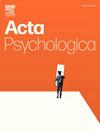Development and preliminary validation of the visual method ‘3D emotion composition’ for evaluating emotional experience in depression
IF 2.1
4区 心理学
Q2 PSYCHOLOGY, EXPERIMENTAL
引用次数: 0
Abstract
Background
Self-reported measures of emotional experience typically rely on verbal recall, which can be challenging for individuals with depression due to difficulties in emotion differentiation and verbal expression. The 3D Emotion Composition (3DEC) method was developed as a visual, tangible, spatial, and interactive tool to facilitate emotion representation through physical objects. This study aimed to develop and preliminarily validate 3DEC as an alternative method for assessing emotional experience in individuals with depression.
Methods
The study was conducted in two phases: (1) development and face validity assessment through expert review and participant feedback, and (2) preliminary validity testing. The 3DEC method was tested for face validity in individuals with and without depression. In the validation phase, 90 participants (45 diagnosed with depression, 45 controls) completed 3DEC and the Emotion Regulation Skills Questionnaire (ERSQ) to assess convergent validity. Known-group validity was examined by comparing 3DEC results between groups.
Results
3DEC showed moderate-to-strong correlations with ERSQ emotion scales (r = 0.30–0.62, p < .001), supporting convergent validity. Known-group comparisons indicated significant differences between patients and controls, with individuals with depression reporting higher sadness, fear, and guilt, and lower joy and interest (p < .001).
Conclusions
These findings provide preliminary evidence for the validity of 3DEC as a visual, tangible, and interactive tool for assessing emotional experience in individuals with depression. By capturing aspects of emotional intensity, frequency, and regulation beyond traditional self-report measures, 3DEC may offer valuable insights into emotional processing. Future studies should evaluate its test-retest reliability, sensitivity to therapeutic change, and potential applications in clinical interventions.
开发和初步验证视觉方法“3D情绪组成”评估抑郁症的情绪体验
情绪体验的自我报告测量通常依赖于言语回忆,这对抑郁症患者来说是一个挑战,因为他们在情绪分化和言语表达方面存在困难。3D情感合成(3DEC)方法是一种视觉、有形、空间和互动的工具,可以通过物理对象来促进情感的表达。本研究旨在发展并初步验证3DEC作为评估抑郁症患者情绪体验的替代方法。方法研究分两个阶段进行:(1)通过专家评审和参与者反馈进行开发和面对效度评估;(2)进行初步效度测试。3DEC方法在患有和不患有抑郁症的个体中进行了面部效度测试。在验证阶段,90名参与者(45名诊断为抑郁症的参与者,45名对照组)完成了3DEC和情绪调节技能问卷(ERSQ)来评估收敛效度。通过比较各组间3DEC结果检验已知组效度。结果3dec与ERSQ情绪量表呈中强相关(r = 0.30-0.62, p <;.001),支持收敛效度。已知组比较表明,患者和对照组之间存在显著差异,抑郁症患者报告的悲伤、恐惧和内疚程度较高,而快乐和兴趣程度较低(p <;措施)。这些发现为3DEC作为评估抑郁症患者情绪体验的视觉、有形和互动工具的有效性提供了初步证据。通过捕捉超越传统自我报告测量的情绪强度、频率和调节方面,3DEC可能为情绪处理提供有价值的见解。未来的研究应评估其重测可靠性、对治疗改变的敏感性以及在临床干预中的潜在应用。
本文章由计算机程序翻译,如有差异,请以英文原文为准。
求助全文
约1分钟内获得全文
求助全文
来源期刊

Acta Psychologica
PSYCHOLOGY, EXPERIMENTAL-
CiteScore
3.00
自引率
5.60%
发文量
274
审稿时长
36 weeks
期刊介绍:
Acta Psychologica publishes original articles and extended reviews on selected books in any area of experimental psychology. The focus of the Journal is on empirical studies and evaluative review articles that increase the theoretical understanding of human capabilities.
 求助内容:
求助内容: 应助结果提醒方式:
应助结果提醒方式:


